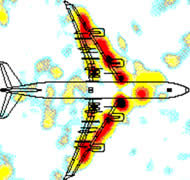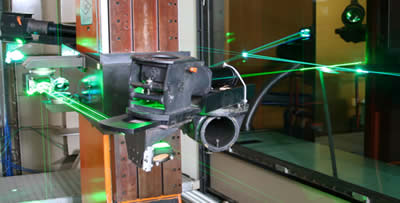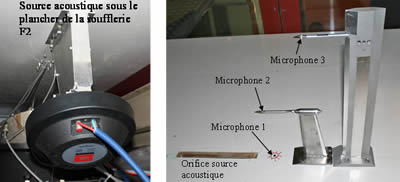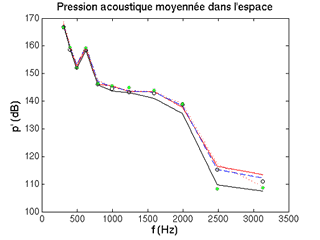A laser to measure noise
A new laser measurement technique makes it possible to locate and characterize the noise at a distance. This is of great interest for aeronautical acoustics!
Number 48
 To eliminate or reduce the noise emissions of an aircraft it is first necessary to locate them (a map obtained using a ground acoustic antenna during the approach phase is shown here). |
When one wants to reduce aeroplane noise related to air flow along the wings*, or aerodynamic noises, it is important to know precisely where they come from and how they are formed. However, it isn’t possible to place sensors everywhere, both because of cost and for sensor sturdiness reasons. In addition, the sensors disturb the air flow, thus modifying the noise. As regards measurements made far from the fuselage, the source of the noise can only be identified using numerous hypotheses and this creates uncertainties. This is why ONERA is developing a new slightly intrusive “acoustic pressure” measurement technique, based on the use of lasers: Laser Doppler Velocimetry (LDV). |
fuselage, elles ne permettent de remonter à la source du bruit qu’en utilisant de nombreuses hypothèses, ce qui engendre des incertitudes. C’est pourquoi l’Onera développe une nouvelle technique de mesure faiblement intrusive de la « pression acoustique » , basée sur l’utilisation de lasers : la vélocimétrie laser Doppler (LDV).

The emission part of the 3D laser velocimetry measuring device of the F2 wind tunnel at the Fauga-Mauzac ONERA centre
Acoustic pressure? It is simply what causes the noise. Sound is in fact a pressure wave propagating through the air, locally producing successive compression and depression phenomena. How can a laser, that is to say, a light source, provide information on sound? In the same way that radars monitor our speed on roads: thanks to the Doppler effect. “By pointing the laser towards the zone that we want to study, we obtain information on the specific speed, that is to say, the speed of the vibrating air molecules, explains Frank Simon, research engineer at the ONERA in Toulouse. However, knowing the acoustic pressure isn’t enough, we must combine these measurements with a model of the wave propagation in the air flow, that is to say, an aero-acoustic propagation model.”

Assembly of a reference acoustic source and microphones in the ONERA Fauga-Mauzac F2 wind tunnel set up to validate the method of acoustic pressure measurement by 3D laser velocimetry.
The advantage of this technique is clear: any point around an aircraft model can be “targeted” in a wind tunnel to establish the acoustic pressure there. “It is like a virtual sensor”, says Frank Simon enthusiastically.
Of course, the concept had to be validated. Measurements have also been made on an aerodynamic test bench designed to validate aero-acoustic calculation software. It was possible to vary the air temperature and the flow speed, as well as the acoustic pressure level. “Some ONERA wind tunnels are equipped with laser velocimeters”, Frank Simon points out. “So both the air flow speed and the acoustic speed related to the sound level can be measured at the same time, this with an unrivalled flexibility.”
The technique also means that absorbent materials placed on the wings or in the engine nacelles can be characterized in a large wind tunnel.

Examples of acoustic pressure levels obtained by 3D laser velocimetry in average flows of 26 m/s, that is to say, close to 95 km/h
Interview and article by Cécile Michaut.